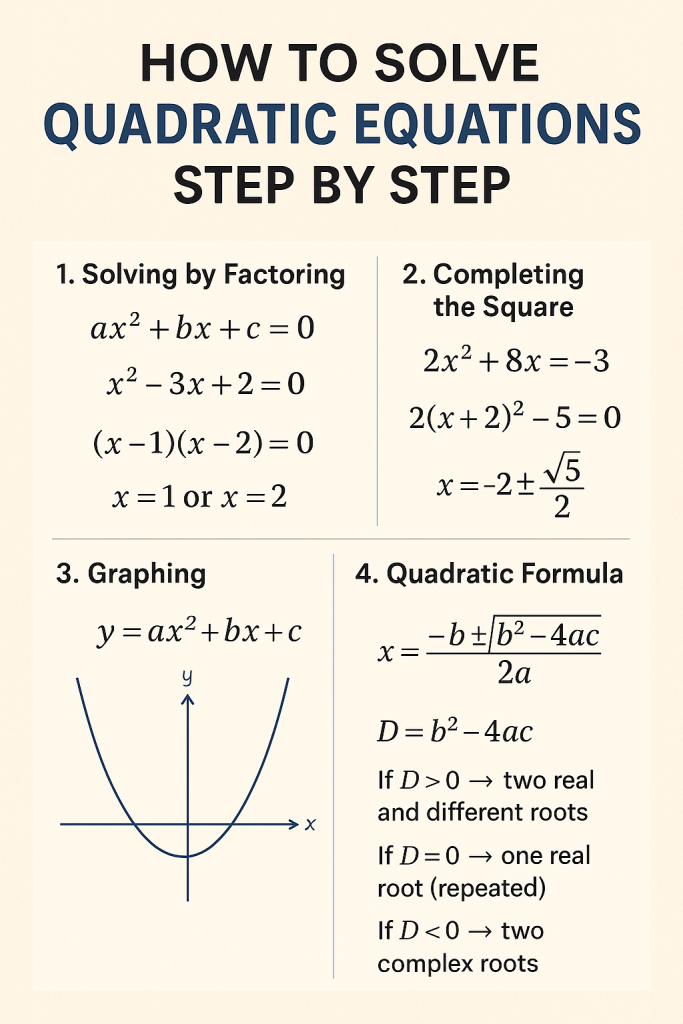Learn how to solve quadratic equations step by step using factoring, completing the square, graphing, and the quadratic formula. Simple explanations with MathJax examples for students.
Quadratic equations often look scary at first, but they don’t have to be. If you’ve ever seen an equation with an $x^2$ term, you’ve already met a quadratic. The word quadratic comes from “quad”, meaning square. In simple terms, a quadratic equation is any equation that can be written in the form:
$( ax^2 + bx + c = 0, ; a \neq 0 )$
The numbers $a, b,$ and $c$ are constants, and your goal is to find the value(s) of $x$ that make the equation true. These values are called the roots or solutions. Since the highest power is 2, a quadratic can have up to two solutions.
For example, in the equation:
$( x^2 – 3x + 2 = 0 )$
the solutions are $x = 1$ and $x = 2$ because both satisfy the equation. But what if the answers are not so obvious? Let’s explore How to Solve Quadratic Equations Step by Step using different methods.

Table of Contents
1. Solving Quadratic Equations by Factoring
Factoring is often the quickest way—if it works.
Steps:
- Write the equation in standard form $(ax^2 + bx + c = 0)$.
- Factorize the quadratic expression.
- Set each factor equal to zero.
- Solve for $x$.
Example: Solve $x^2 – 3x + 2 = 0$
$(x – 1)(x – 2) = 0$
$x = 1 \quad \text{or} \quad x = 2$
✔ Easy! But keep in mind: not all quadratics can be factored nicely.
2. Solving Quadratic Equations by Completing the Square
This method feels a bit longer, but it always works. It turns the equation into something like $(x – h)^2 = k$.
Example: Solve $2x^2 + 8x = -3$
Step 1: Bring everything to one side
$(2x^2 + 8x + 3 = 0)$
Step 2: Complete the square
$(2(x + 2)^2 – 5 = 0)$
Step 3: Solve
$((x + 2)^2 = \tfrac{5}{2})$
$(x = -2 \pm \tfrac{\sqrt{10}}{2})$
So, the roots are:
$(x = \tfrac{-4 + \sqrt{10}}{2}, ; x = \tfrac{-4 – \sqrt{10}}{2})$
This method helps when factoring isn’t possible.
3. Solving Quadratic Equations by Graphing
Sometimes, a picture is worth more than algebra. If you graph the quadratic function:
$(y = ax^2 + bx + c)$
the points where it crosses the x-axis are the solutions.
Example: Solve $3x^2 – 11x + 5 = 0$
Graphing this shows two intercepts at about $(x \approx 0.53)$ and $(x \approx 3.13)$.
👉 Note: Graphing is great for visual understanding, but it usually gives approximate answers unless you use exact methods like factoring or the quadratic formula.
4. Solving Quadratic Equations by the Quadratic Formula
When all else fails (or when you want a guaranteed method), use the quadratic formula:
$(x = \tfrac{-b \pm \sqrt{b^2 – 4ac}}{2a})$
Here, the part under the square root, $(b^2 – 4ac)$, is called the discriminant (D). It tells you about the type of solutions:
- If $(D > 0)$ → two real and different roots
- If $(D = 0)$ → one real root (repeated)
- If $(D < 0)$ → two complex roots
Example: Solve $2x^2 – 3x + 5 = 0$
$a = 2, ; b = -3, ; c = 5$
$D = (-3)^2 – 4(2)(5) = -31$
Since $(D < 0)$:
$(x = \tfrac{3 \pm i\sqrt{31}}{4})$
→ Two complex roots.
Special Cases
- Missing b-term:
$(x^2 – 4 = 0 \quad \Rightarrow \quad x = \pm 2)$
- Missing c-term:
$(x^2 – 5x = 0 \quad \Rightarrow \quad x(x – 5) = 0 \quad \Rightarrow \quad x = 0 ; \text{or} ; 5)$
Why Learn Multiple Methods?
Each method has its own advantage:
- Factoring → quick and neat (if factorable)
- Completing the square → good for practice and vertex form
- Graphing → visual and intuitive
- Quadratic formula → always works
Quick Practice Example
A park’s length is 5 ft less than twice its width, and its area is 250 ft². Find its dimensions.
Width = $x$, Length = $(2x – 5)$
$\text{Area} = x(2x – 5) = 250$
$(2x^2 – 5x – 250 = 0)$
Factoring:
$((2x – 25)(x + 10) = 0)$
$(x = 12.5 \quad (\text{positive root}))$
✅ Width = 12.5 ft, Length = 20 ft
Final Thoughts
Quadratic equations are everywhere—in physics, finance, construction, even sports. Once you understand the methods, they become less intimidating.
Learn : How to Solve Quadratic Equations Step by Step
- Start with factoring,
- Try completing the square,
- Explore graphing, and
- Master the quadratic formula.
With practice, solving quadratics will feel natural.
Learn about World War 2 Timeline Overview
